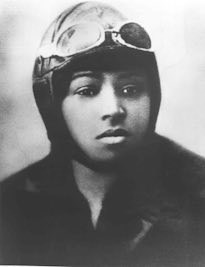The world’s first Black woman aviator, Bessie Coleman, earned her pilot’s license in 1921 in France, two years before her more famous contemporary, Amelia Earhart.
Bessie Coleman, the tenth child in a family of thirteen, grew up in a large, single-parent family in rural Texas. She learned about aviation through childhood reading, finished high school and some teacher’s college training, and moved to Chicago. There, she was mentored by two Black philanthropists, Robert Abbott and Jesse Binga. Denied admission to American aviation schools because of her race and gender, she learned French and went to France. In 1921 she earned an international pilot’s license from the highly respected Federation Aeronautique International.
She returned to the United States and spent the next five years touring the country, giving exhibition flights, barnstorming and parachuting at airports. Earning the nickname Queen Bess, she challenged the barriers of racial discrimination and refused to participate in segregated events. She planned to open an aviation school to teach other Black Americans to fly and become an active part of the growing aviation industry.
Tragically, her life and dream ended in her untimely death on April 30, 1926 during an exhibition accident when she fell from the plane and died instantly. She left a substantial legacy because of her modeling a pathway for women and people of color in aviation and her challenges to Jim Crow practices. Bessie Coleman is honored every year by pilots dropping wreaths from the air over her gravesite.

